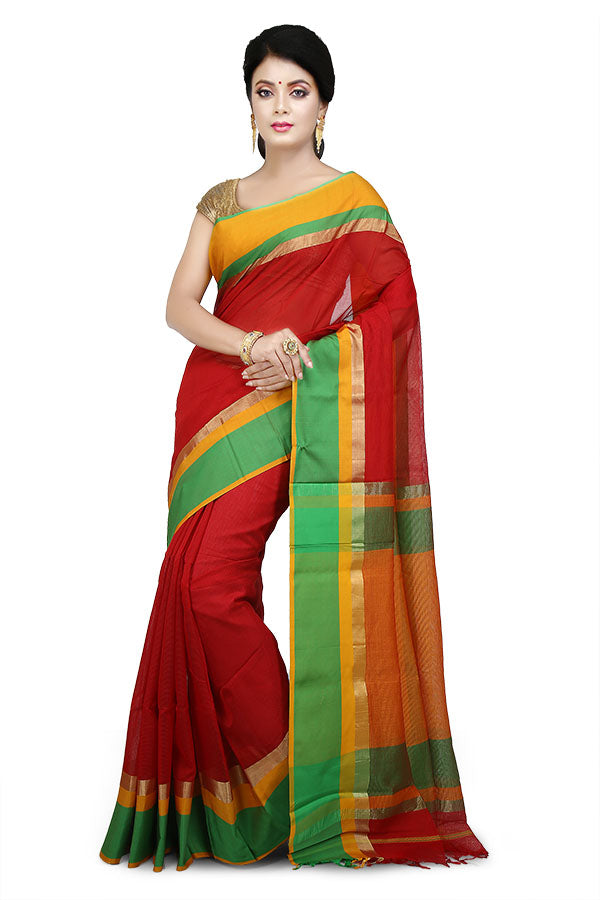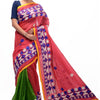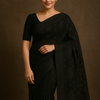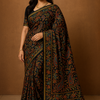Maheshwari Sarees Sitting at the Peak of Indian Ethnic Fashion
- Posted by Banglarsare Handloom

There is a small town on the banks of Maa Rewa (Narmada river), quite historic. Time stands still here in the Indian middle ages, with antiquated buildings and shops. And this beautiful little town is the birthplace and the only origin of the internationally known Maheshwari sarees.
In the apex of Indian saree fashion, the sarees take their name from the town’s name — Maheshwar — and are one of the brightest examples of how beautiful and powerful Indian handloom can be. The Maheshwaris can be easily recognized by the trademark reversible border better known as the Bugdi to the locals.
Dating back as far as the 5th century, the Maheswari sarees are as glorious as they are beautiful. Legend has it that when Queen Ahalyabai Holkar wanted to charm her guests on the occasion of ascension to the throne, she wanted her weavers to produce something truly unseen before. But not happy with their work, she herself designed a 9-yard cotton piece, which was an instant hit in her court and indeed was the first Maheshwari.
Though it has evolved since then, a Maheshwari saree still bears the same regal attitude it had then. With pallus on both ends, this saree can be draped on either side, making it as versatile as it is durable. An apt garment to be worn on any prestigious occasion — from royal gardens to holy temples — this saree has become the fashion icon of Madhya Pradesh.
Naturally, it is not easy to produce something as rich and prestigious, especially when you have to do it by hand almost entirely. The fabric is soft and lightweight, to begin with, being produced by sturdy pit looms fixed to the ground. Then it is enriched by weaving traditional patterns with zari, kinara, gold and gemstones. The saree also gets a kind of glossy finish, putting the royal signature touch.
There are five types of Maheshwari sarees, depending upon the quality and type of the weaving work done on the cotton. The rather plainer and thus cheaper (still beautiful) ones are grouped into Chandrakala and Baingani Chandrakala types. The Chandratara, Beli and Parbi, on the other hand, display bold stripes and checks.
Visit Our Website!
If you want to buy Maheshwari sarees, visit the website of Banglar Saree. You can check the variety of sarees and buy according to your choice.Please select collection from store admin > customize > Collection page > sidebar
- Affordable and stylish cotton sarees online
- Affordable Bengali Sarees
- Affordable Hand Painted Saree Online
- affordable Jamdani sarees
- Affordable kantha saree
- airport fashion
- Art Sarees Online
- Artisan embroidered sarees
- Artistic Saree Online
- authentic hand-painted sarees
- Authentic Handloom Saree
- authentic handloom sarees
- Authentic Handloom Sarees Online
- Authentic handwoven sarees
- Authentic Jamdani saree
- Authentic Kantha saree
- Authentic Kantha Sarees
- authentic kantha stitch saree
- Authentic Muslin saree Kolkata
- Baluchari Saree
- Baluchari Silk Saree
- baluchari silk sarees
- Banarasi
- Banarasi vs Jamdani saree
- Bangalore pure silk saree
- Bangalore sarees
- Bangalore silk kantha saree online
- Banglarsare handloom collection
- Banglarsare handloom sarees
- BANGLARSARE HANDLOOM UDYOG
- BANGLARSARE HANDLOOM UDYOG Sarees
- Banglarsare kantha silk saree online
- Banglarsare.com cotton sarees
- Banglarsare.com sarees
- Banlarsare affordable handloom sarees
- beachwear saree
- Bengal Handloom Saree
- Bengal Kantha embroidery
- Bengal Kantha embroidery saree
- Bengal Kantha sarees
- Bengali Atpoure style
- Bengali draping style
- Bengali embroidery design
- Bengali Hand Painted Saree Online
- Bengali Kantha sarees
- Bengali kantha stitch saree
- Bengali saree care guide
- Bengali Saree Collection
- Bengali saree for wedding
- Bengali Saree Shop Online
- Bengali saree types
- Bengali sarees
- Bengali Sarees for Women
- Bengali silk sarees
- Bengali Tant Saree
- Bengali Tant sarees
- Best Cotton Saree
- Best cotton sarees
- best cotton sarees for summer
- Best fabric sarees for Holi festival
- Best gift ideas with Kantha embroidery sarees
- Best hand painted sarees for festivals
- Best handloom cotton sarees for everyday use
- Best handloom sarees for Mahashivratri
- Best Jamdani sarees for weddings and festivals
- Best kantha stitch sarees for partywear
- Best online saree store Kolkata
- Best Saree Accessories for Eid
- Best saree colors for Holi festival
- Best saree colors for skin tone
- best saree for haldi ceremony
- best sarees for daily wear in Kolkata
- Best sarees for gifting
- Best sarees for Holi
- Best sarees for weddings
- Best way to clean tant saree
- Best ways to reuse old handloom sarees
- blended silk kantha saree
- Blouse Designs
- Bomkai Silk Saree
- Braided hairstyles for sarees
- Breathable sarees for summer
- Bridal hairstyles for silk sarees
- bridal saree for haldi
- bright yellow saree for bride
- budget Jamdani sarees
- Budget Tant Sarees
- Buy authentic Kantha silk sarees online
- buy Bengali cotton sarees online
- Buy Bengali sarees online
- Buy Cotton Saree Online
- Buy Eid Sarees Online
- Buy Hand Painted Sarees
- buy handloom sarees online
- buy Jamdani saree online
- Buy Jamdani sarees online
- Buy Kantha saree online
- Buy Kantha stitch saree online
- Buy Muslin Silk Saree at Best Price
- Buy Muslin Silk Sarees Online
- Buy Online Hand Painted Saree
- Buy sarees online for Mahashivratri
- Buy sarees online Kolkata
- Buy Tant Saree Online
- Caring for handwoven Jamdani sarees
- Casual cotton sarees
- Casual hairstyles for sarees
- Celebrity saree hair looks
- Celebrity-inspired hairstyles
- Chic hairstyles for festive sarees
- chic travel outfits
- chiffon yellow saree
- Classic bun for sarees
- Colorful sarees for Holi
- Comfortable Cotton Saree
- Comfortable sarees for women
- Contemporary Eid Saree Looks
- Contemporary hairdos for traditional sarees
- Cotton Hand Painted Saree
- cotton Jamdani saree
- Cotton saree for daily wear
- Cotton Saree for Summer
- Cotton Saree Online
- Cotton Saree Online Shopping
- Cotton sarees for Holi
- cotton sarees online Kolkata
- Creative ideas for upcycling old sarees
- cultural fashion
- Cultural heritage sarees
- cultural importance of yellow saree
- Custom Hand Painted Saree
- Daily Wear Cotton Saree
- Designer Cotton Saree
- Designer Hand Painted Sarees
- Designer Jamdani saree
- Designer Kantha silk sarees
- Designer kantha stitch saree under ₹4000
- Designer Sarees for Eid
- dhakai jamdani saree
- Dhakai Jamdani saree under 4000
- Dhakai Jamdani Sarees
- Dhakai Jamdani sarees online
- difference between handloom and powerloom sarees
- DIY home décor with Kantha work fabrics
- DIY Kantha fabric ideas
- Duel Thread Work Kantha Stitch Saree
- Easy-to-maintain sarees
- Eco-friendly fashion
- Eid Saree Styles
- Eid Sarees in Bangladesh
- Elegant Eid Sarees
- Elegant Farewell Outfit
- Elegant hairstyles for sarees
- elegant saree for haldi
- elegant travel wear
- Elegant updos for sarees
- Embroidered Sarees for Eid
- Ethnic wear for Holi
- Famous sarees of Kolkata
- Farewell Party Saree
- Fashion trends
- Fashionable Saree Look
- Festival sarees
- Festive Saree Collection
- Festive Sarees Online
- Festive Silk Sarees
- Fishtail braid saree hairstyle
- Floral Print Sarees
- Genuine Kantha stitch saree
- Georgette sarees for Holi
- georgette yellow saree
- Gorgeous Kantha Stitch Sarees
- guide to buying cotton sarees online
- Gujarati stitch kantha saree at best price
- Gujarati Stitch sarees
- Gujrati Stitch Saree
- Hair accessories for sarees
- Hairstyles for Bangalore printed silk sarees
- Hairstyles for formal events with sarees
- Hairstyles for Indian sarees
- Hairstyles to complement saree embroidery
- haldi ceremony attire
- haldi ceremony outfit ideas
- haldi ceremony saree
- haldi dress for bride
- haldi saree look
- haldi special sarees
- half-down hairstyle saree
- Half-up
- Hand embroidered kantha saree
- Hand embroidered Kantha sarees
- Hand Painted Saree Kolkata
- Hand Painted Saree Online Kolkata
- Hand Painted sarees
- Hand Painted Sarees Online
- Hand painted sarees with blouse piece
- hand stitch saree
- Hand thread work kantha saree online
- hand thread work saree
- Hand Work Pure Kantha Stitch Saree
- hand-embroidered
- Hand-Embroidered Kantha Sarees
- hand-painted sarees
- Hand-painted sarees online
- Handcrafted Kantha saree
- Handcrafted Kantha Stitch Sarees
- Handcrafted Saree Designs
- Handcrafted sarees
- Handcrafted Sarees Online
- Handloom Cotton Saree
- Handloom Cotton sarees
- Handloom cotton sarees 2025
- handloom cotton sarees online
- Handloom Hand Painted Sarees
- Handloom Muslin saree online
- Handloom Organic Sarees
- Handloom saree maintenance
- Handloom Sarees for Eid
- Handloom sarees for Mahashivratri
- Handloom Sarees for Nobo Barsho
- Handloom sarees from Bengal
- handloom sarees Kolkata
- Handloom sarees online
- Handloom Tant Sarees
- Handmade fabric crafts
- Handmade Kantha saree
- Handmade Kantha sarees
- Handmade sarees online
- Handwoven Cotton Saree
- Handwoven Jamdani saree
- handwoven sarees India
- Heritage handloom sarees
- History of Hand-Painted Sarees
- Holi fashion tips
- Holi outfit ideas
- Holi sarees
- Holi special sarees
- How to choose a cotton saree for daily wear
- how to choose cotton saree
- How to choose the best saree for Holi
- How to identify an original Jamdani saree
- how to identify authentic handloom sarees
- How to keep saree fresh
- How to maintain a tant saree
- How to repurpose old Kantha stitch sarees
- How to style a saree for Holi
- Indian handloom sarees
- Indian Sarees for Eid
- Indian sarees for Holi
- Ironing tips for tant saree
- Jamdani saree
- Jamdani saree collection
- jamdani sarees
- Jamini Roy Saree
- Jewel Tone Sarees
- Kanjeevaram
- Kantha embroidery
- Kantha embroidery sarees
- Kantha embroidery silk sarees
- kantha saree identification
- kantha saree online
- Kantha saree online shopping
- Kantha saree shopping tips
- Kantha saree under 4000
- Kantha sarees and their cultural significance
- Kantha sarees for gifting
- Kantha sarees for special occasions
- Kantha sarees heritage
- Kantha sarees online
- Kantha sarees vs machine-made
- Kantha Sarees with Blouse Piece
- Kantha silk for weddings
- Kantha silk sarees
- Kantha silk sarees for weddings and festivals
- kantha stich saree
- Kantha stitch creativity
- Kantha stitch embroidery
- Kantha stitch saree
- Kantha Stitch Saree design
- Kantha Stitch Saree on Tussar Silk
- Kantha stitch saree online
- Kantha stitch saree price
- Kantha stitch saree reuse
- kantha stitch sarees
- Kantha Stitch sarees Kolkata
- Kantha stitch silk saree
- Kantha work fabrics
- Kantha work home décor
- kantha work saree
- Kantha work saree Kolkata
- Kantha work sarees
- Kantha work sarees Kolkata online
- Kolkata handloom saree shops online
- Kolkata sarees online
- Latest saree trends 2025
- Latest sarees for women in Kolkata
- Lightweight Cotton Saree
- Lightweight cotton sarees
- Lightweight sarees for all-day comfort
- Lightweight sarees for festive occasions
- Lightweight sarees for Holi celebrations
- Lightweight sarees for summer
- Linen Saree for Summer
- Luxurious Silk Fabric
- Luxury ethnic wear
- Luxury Sarees for Eid
- machine made kantha saree
- Madhubani Print Saree
- Mahashivratri 2025 sarees
- Mahashivratri special saree collection
- Maheshwari Silk Cotton sarees
- Messy bun saree look
- Midnight Blue Kantha Stitch Saree
- Modern hairstyles for sarees
- Modern Jamdani sarees
- Modern Saree Draping Styles
- Modern Saree Trends
- Modern twists on traditional saree hairstyles
- Monochrome Eid Sarees
- Multi-Colour Kantha Stitch Saree
- Murshidabad silk saree
- Murshidabad Silk Sarees
- Muslin Jamdani saree
- Muslin Jamdani sarees online India
- Muslin saree
- Muslin Silk Saree
- Muslin silk saree for wedding
- mustard yellow saree for haldi
- Office wear sarees
- Old saree makeover
- Online Eid Saree Shopping
- Online Muslin saree
- Online Muslin silk saree in Kolkata
- Online saree boutique Kolkata
- Online Saree Shopping for Poila Baishakh
- Online Saree Shopping Kolkata
- Online traditional sarees for women
- Organic handloom sarees Kolkata
- Organza Eid Sarees
- Pallu Designs
- partywear Jamdani saree
- Partywear Kantha Sarees
- Pastel Sarees for Eid
- Perfect hairdos for Indian weddings
- Poila Baishakh Saree
- Preserve tant saree fabric
- Prevent saree color fading
- Printed Sarees for Eid
- pure cotton handloom sarees
- Pure Cotton Saree
- Pure Handloom Organic sarees
- Pure Silk Hand Painted Saree
- Pure silk kantha saree
- Red silk hand painted saree online
- Removing stains from saree
- Repurpose vintage sarees
- Repurposed silk sarees
- Reuse Kantha embroidery
- Saree Blouse Designs
- Saree color
- Saree color guide
- Saree color trends
- Saree draping styles
- Saree for a Farewell Party
- Saree for a Party
- Saree for College Farewell
- saree for haldi ceremony for bride
- saree for pre-wedding rituals
- Saree maintenance hacks
- Saree storage solutions
- Saree Store in Kolkata
- Saree Styling Tips for Eid
- Saree trends 2025
- Sarees for Bengali New Year
- Sarees for Holi
- Seal Brown Kantha Stitch Saree
- Shantiniketan Kantha Stitch Saree
- Shantiniketan silk kantha saree online
- Shop Muslin silk sarees with zari
- sightseeing outfits
- Silk Kantha sarees
- Silk Muslin sarees
- Silk Saree for Farewell
- Silk sarees with embroidery
- silk yellow saree for haldi
- Sleek ponytail for saree
- Soft breathable cotton sarees
- Soft Cotton Saree for Women
- Soft cotton sarees
- soft Jamdani saree
- Soft waves hairstyle
- Stylish saree hairdos
- stylish saree looks
- Summer Special Cotton Saree
- Sustainable fashion ideas
- Sustainable fashion sarees
- Sustainable fashion with recycled silk sarees
- Sustainable sarees online
- Swarnachari saree
- Taant Cotton Saree
- Tangail Jamdani saree
- Tant saree care
- Tant Saree Collection
- Tant Saree for Festival
- Tant saree online
- Tant saree preservation tips
- Tant Saree under 2500
- Tant Silk Saree Online
- Timeless Farewell Fashion
- Timeless Saree Fashion
- Tips for styling a Jamdani saree
- Top Hand Painted Sarees
- Traditional Bengal sarees
- Traditional Bengali Saree
- Traditional Bengali sarees
- Traditional Cotton Saree
- Traditional Eid Sarees
- Traditional embroidery upcycling
- Traditional hairstyles for sarees
- Traditional Hand Painted Saree
- Traditional handwoven Kantha silk sarees
- Traditional Indian hairstyles
- Traditional Indian sarees
- traditional Jamdani saree
- Traditional kantha saree designs
- Traditional Kantha sarees
- Traditional Kantha stitch saree
- Traditional Muslin sarees India
- Traditional saree
- Traditional saree care guide
- Traditional Saree Styles
- Traditional sarees for Holi
- Traditional sarees for Mahashivratri
- Traditional Sarees for Poila Baishakh
- Traditional sarees for puja celebrations
- traditional yellow saree
- Traditional yet modern cotton sarees for women
- Transforming Kantha embroidery into accessories
- travel fashion
- Trendy Eid Sarees Online
- Tussar silk Kantha saree
- Tussar Silk Saree
- Tussar silk saree Bengal
- Tussar Silk Sarees Online
- Types of sarees in Bengal
- Unique gift ideas using old Kantha embroidery
- Unique gift ideas with Kantha sarees
- Unique hand painted sarees India
- Unique handcrafted sarees
- Unique handwoven sarees for women
- Upcycling old sarees
- Uppada Jamdani saree
- Vibrant Colors
- Washing tips for tant saree
- Wedding hairstyle ideas for sarees
- What to wear for Holi celebrations
- Where to buy authentic Jamdani sarees online
- Where to buy hand painted sarees online
- where to buy handloom cotton sarees in Kolkata
- Where to buy kantha sarees online
- Where to buy Mahashivratri sarees online
- White Stylish Kantha Stitch Saree
- why choose saree for haldi
- yellow saree
- yellow saree for bride
- yellow saree for haldi
- yellow saree for Indian weddings
- yellow saree ideas for haldi
- yellow saree significance
- yellow saree styles
- yellow saree with floral jewelry
- Zari Work Sarees






